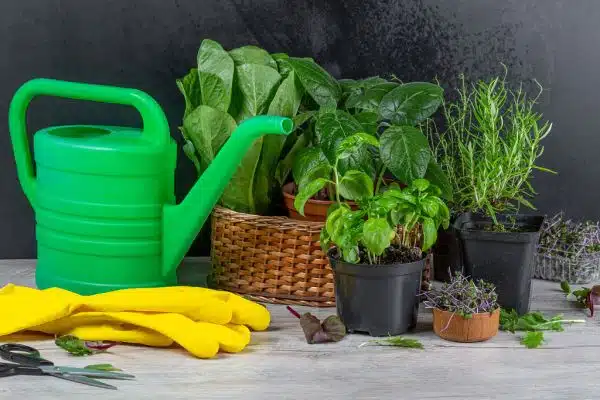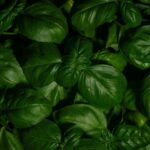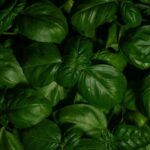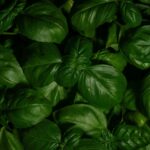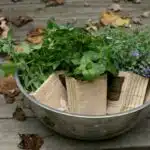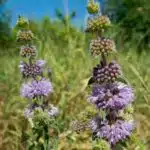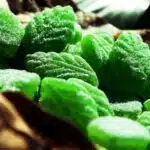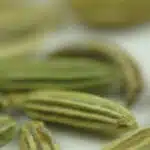Herbs have been used for centuries in culinary dishes, medicinal remedies, and even for spiritual practices. With the rise of urbanization and limited space, growing herbs in pots has become a popular choice for many gardeners. Not only does it offer convenience and accessibility, but it also adds a touch of greenery to any indoor or outdoor space.
In this article, we will explore 5 great herbs to grow in pots. Whether you’re a beginner or seasoned gardener, these herbs are easy to grow and maintain. From the fragrant aroma of basil to the versatile uses of rosemary, these herbs not only add flavor to your meals but also provide numerous benefits for your health and well-being. So grab your gardening gloves and let’s get started on creating a thriving herb garden!
The Benefits Of Growing Herbs In Pots
Growing herbs in pots is a great way to enjoy fresh, aromatic herbs right at home. Aside from providing an easy access to those flavorful leaves, there are several benefits to growing herbs in pots. For one, herbs grown in containers can be moved around easily, making it possible to adjust the amount of sunlight and shade they receive depending on their needs. This also means that you can bring your herb garden indoors during colder months, prolonging the life of your plants.
Another benefit of growing herbs in pots is that it allows for better control over soil quality and moisture content. By using a good potting mix and proper maintenance techniques like regular watering and fertilizing, you can ensure that your herbs are getting all the nutrients they need to thrive. Furthermore, growing herbs in containers greatly reduces the risk of pests and diseases that commonly affect outdoor gardens.
Maintaining an herb garden in pots does require some effort, but it is well worth it for the convenience and benefits it provides. With a few simple steps like pruning back regularly and keeping an eye out for any signs of disease or pests, you can keep your container garden healthy and productive for many seasons to come.
To ensure that your herbs thrive in their new homes, choosing the right pot is crucial. In the next section, we will discuss different factors you should consider when selecting a container for your herb garden.
Choosing The Right Pot For Your Herbs
When it comes to choosing the right pot for your herbs, size matters. It is important to choose a pot that is appropriate for the size of your herb plant. If you choose a pot that is too small, your plant may become root-bound and struggle to grow. On the other hand, if you choose a pot that is too large, excess soil can hold water and lead to root rot.
The best materials for herb pots are those that provide good drainage while retaining moisture. Terracotta pots are popular due to their porous nature, which allows air and moisture to pass through. However, they can dry out quickly in hot weather and may require frequent watering. Plastic pots are lightweight and retain moisture well but don’t allow for as much air circulation as terracotta. Metal pots can heat up quickly in direct sunlight and may not be suitable for all types of herbs.
Now that you have an idea of what size and material to look for in an herb pot, it’s time to consider where you will be placing it. Make sure your chosen spot receives adequate sunlight and has easy access to water. Once you have found the perfect location, it’s time to move on to understanding soil and fertilizer needs for your herbs.
Understanding Soil And Fertilizer Needs
Now that you have chosen the right pot for your herbs, it’s time to focus on soil preparation and fertilizer application. Proper soil preparation is essential for the healthy growth of your herbs. First, you need to choose a good quality potting mix that is well-draining and nutrient-rich. You can also make your own potting mix by combining equal parts of peat moss, perlite, and vermiculite.
Once you have prepared the soil, it’s important to apply fertilizer at regular intervals. A balanced liquid or granular fertilizer with equal amounts of nitrogen, phosphorus, and potassium is ideal for most herbs. However, it’s important to follow the instructions carefully and avoid over-fertilizing as this can lead to burned roots and stunted growth.
In summary, proper soil preparation and fertilizer application are crucial for growing healthy herbs in pots. By choosing a good quality potting mix and applying fertilizer at regular intervals, you can ensure that your plants receive the necessary nutrients for optimal growth. In the next section, we will discuss proper watering techniques for herbs in pots that will help you maintain healthy plants all year round.
Proper Watering Techniques For Herbs In Pots
Watering your herbs in pots is an essential component of their growth and development. However, many beginners make common mistakes when it comes to watering their herbs, which can harm or even kill the plants. Here are some tips to help you avoid these mistakes and keep your herbs healthy.
The first tip is to water your herbs deeply but infrequently. Overwatering is a common mistake that many beginners make, which can lead to root rot and other diseases. The best way to water your herbs is to wait until the soil surface is dry before watering again. This will ensure that the water reaches the roots without drowning them.
Another important tip is to use a watering can or hose with a gentle spray nozzle. Directing a strong stream of water onto the soil can disturb the delicate roots and compact the soil, making it difficult for water and air to penetrate. A gentle spray will help distribute the water evenly and prevent damage to the plant.
By following these watering tips for beginners, you can help ensure that your herb garden thrives in pots. In the next section, we will discuss how to choose the best location for your herb garden, so stay tuned for more helpful tips on growing healthy herbs at home.
The Best Location For Your Herb Garden
Proper watering techniques are essential for the health and growth of herbs in pots, but equally important is choosing the best potting mixes and finding the ideal lighting conditions. The success of growing herbs in containers starts with selecting high-quality potting soil that is light, well-draining, and rich in organic matter. Avoid using garden soil, which can become compacted, retain too much moisture, and contain weed seeds or pests.
The type of soil mix you select will depend on your specific herb’s needs. For example, Mediterranean herbs like rosemary, thyme, or oregano prefer a sandy mix that drains easily, while leafy greens like lettuce or spinach require a richer blend that retains moisture. You may also consider adding perlite or vermiculite to improve drainage and aeration.
Lighting conditions are equally crucial when it comes to growing herbs in pots. Most herbs require at least six hours of direct sunlight each day to thrive, although some varieties can tolerate partial shade. If you have limited access to natural light or live in an area with harsh winters or little sunlight, consider investing in artificial grow lights that mimic natural daylight.
Basil: an easy-to-grow herb with many uses is one of the most popular herbs grown in pots due to its versatility and delicious flavor. This annual herb prefers well-drained soil mixtures with moderate moisture levels and requires full sun exposure for optimal growth. If planted indoors, basil needs at least 6-8 hours of direct sunlight per day or 12-14 hours under artificial lighting. With proper care and attention to your potting mix and lighting conditions, you can enjoy fresh basil leaves all year round!
Basil: An Easy-To-Grow Herb With Many Uses
Basil is a herb that symbolizes love and fertility. It is a versatile herb that has many uses beyond cooking. Basil’s fragrance can fill the air with its sweet aroma, and it can add flavor to any dish. Its leaves are soft and delicate, making it an ideal herb to grow in pots.
Basil has many uses beyond cooking, such as medicinal purposes. Basil tea can help soothe an upset stomach, reduce stress levels, and improve digestion. Additionally, basil oil can be used in aromatherapy to provide relief from anxiety and depression. The herb also has anti-inflammatory properties that make it useful for treating minor skin irritations.
Preserving fresh basil is easy if you follow some simple tips. Firstly, avoid washing the leaves until you’re ready to use them because moisture will cause them to spoil quickly. Secondly, trim the stems of your basil plant regularly to encourage new growth and prevent it from becoming too tall or leggy. Lastly, freezing fresh basil in ice cube trays with olive oil is an excellent way to preserve its flavor for future use.
Rosemary: A versatile herb for cooking and healing is another fantastic option for your gardening adventures. It’s a hardy plant that thrives in pots, making it a great choice for novice gardeners who want something low maintenance but still useful in the kitchen and medicine cabinet alike!
Rosemary: A Versatile Herb For Cooking And Healing
Rosemary is an herb that is widely used in cooking and healing due to its versatility. It is a hardy plant that can be easily grown in pots, making it an ideal choice for those who want to have fresh herbs on hand all year round. Rosemary propagation is relatively easy, and the plant can be grown from cuttings or seeds.
Apart from its culinary uses, rosemary has also been known for its medicinal properties for centuries. Rosemary essential oil is extracted from the leaves of the plant and has been used as a natural remedy for various ailments such as headaches, muscle pain, and respiratory issues. The oil can also be added to skin care products due to its anti-inflammatory properties.
Overall, growing rosemary in pots is an excellent way to have this versatile herb readily available at all times. Whether you use it in cooking or as a natural remedy, rosemary is a must-have plant in every home garden. In the next section, we will explore another herb that not only adds flavor but also has many health benefits: mint.
Mint: A Refreshing Herb With Many Health Benefits
Rosemary is a popular herb for cooking and healing due to its versatility. Did you know that rosemary was once considered a sacred plant in ancient Greece? It was believed to have magical properties and was used to ward off evil spirits. Today, rosemary is commonly used in Mediterranean cuisine and has a variety of health benefits such as improving memory and reducing inflammation.
Moving on from rosemary, let’s talk about mint. Mint is another herb that is easy to grow in pots and provides many health benefits. One of the most popular ways to consume mint is through tea. Mint tea has been shown to aid digestion, reduce stress levels, and improve sleep quality. Additionally, mint can be used in a variety of recipes such as salads, smoothies, and desserts.
If you’re looking for some new mint recipes to try out, consider making a refreshing cucumber-mint salad or adding fresh mint leaves to your favorite fruit smoothie. You can also use mint to make homemade ice cream or chocolate truffles for a delicious treat. With its versatility and numerous health benefits, it’s no wonder why mint is such a popular herb among horticultural enthusiasts.
Transitioning into our next section, let’s take a look at thyme: a fragrant herb with culinary and medicinal uses. Thyme has been used for centuries in traditional medicine for its antiseptic properties and has been shown to improve respiratory health. In the kitchen, thyme adds flavor to soups, stews, and roasted meats. Whether you’re looking for new ways to enhance your cooking or want to explore the medicinal benefits of herbs, thyme is certainly worth experimenting with in your garden or kitchen.
Thyme: A Fragrant Herb With Culinary And Medicinal Uses
Thyme is a popular herb that many gardeners love to grow in pots. It is a versatile herb that can be used for culinary and medicinal purposes, making it a great addition to any kitchen garden. Thyme has a fragrant aroma that is perfect for adding flavor to dishes like soups, stews, and sauces.
Growing thyme in pots is relatively easy, as long as you follow some basic growing techniques. The first step is to choose the right potting mix, one that will provide good drainage and plenty of nutrients for the plant. Thyme prefers well-drained soil with a pH between 6.0 and 7.0. It also likes full sun exposure, so make sure your pot is located in an area where it can receive at least six hours of direct sunlight each day.
In terms of culinary uses, thyme is an essential herb in many cuisines around the world. Its earthy flavor pairs well with meats like chicken, beef, and lamb, as well as vegetables like potatoes and carrots. Thyme can be used fresh or dried, depending on the recipe you are using. In addition to its culinary uses, thyme has been used for centuries as a natural remedy for coughs, colds, and other respiratory ailments due to its antibacterial properties.
Moving on from thyme, another great herb to grow in pots that has both culinary and medicinal uses is parsley. Like thyme, parsley prefers well-drained soil and full sun exposure. It is an excellent source of vitamins A and C and can be used fresh or dried in various recipes such as salads or soups.
Parsley: A Nutritious Herb For Culinary And Medicinal Purposes
Thyme, with its delicate aroma and versatile uses, is a great herb to grow in pots. But if you’re looking for another herb that can offer both culinary and medicinal benefits, consider growing parsley. With its bright green leaves and mild flavor, parsley has been used for centuries in cooking and as a natural remedy for various ailments.
Aside from being a popular garnish, parsley is an excellent source of nutrients like vitamins A and C, iron, and folate. It also has anti-inflammatory properties that can help alleviate joint pain and other inflammatory conditions. Moreover, incorporating parsley into your diet is easy since it can be added to a variety of dishes from soups and stews to salads and smoothies.
If you’re interested in exploring more ways to use parsley beyond its decorative appeal, here are some ideas to get you started:
- Parsley recipes:
- Tabouli salad: a traditional Middle Eastern dish made with bulgur wheat, tomatoes, onions, lemon juice, olive oil, and lots of chopped parsley.
- Chimichurri sauce: a tangy Argentine condiment made with fresh parsley leaves, garlic, red pepper flakes, vinegar or lemon juice, and olive oil.
- Parsley pesto: a variation of the classic basil pesto that uses parsley leaves instead of basil leaves.
In addition to its culinary uses, drinking parsley tea has many health benefits. For instance:
- Parsley tea benefits:
- Helps detoxify the body by flushing out toxins
- May lower blood pressure due to its diuretic effect
- Can aid digestion by reducing bloating and gas
- May improve kidney function by increasing urine output
Overall, growing parsley in pots is an excellent way to have fresh herbs on hand for both cooking and natural healing purposes. So why not try adding some parsley plants to your garden or windowsill today?
Cilantro: A Flavorful Herb For Mexican And Asian Cuisine
Cilantro, also known as coriander, is a flavorful herb that is commonly used in Mexican and Asian cuisine. It has a distinct citrusy and slightly spicy flavor that adds depth to dishes. Growing cilantro in pots is relatively easy and can be done by following some simple growing techniques.
Cilantro prefers well-draining soil with pH ranging from 6.2 to 6.8. The pot should be at least six inches deep and wide enough to accommodate the plant’s root system. It is important to keep the soil moist but not waterlogged, as overwatering can cause root rot. Cilantro thrives in partial shade or full sun, depending on the climate.
Culinary uses of cilantro are numerous; it can be used fresh or dried in soups, stews, salads, salsa, guacamole, and many other dishes. The leaves and stems are edible and provide a burst of flavor when added to dishes just before serving. Cilantro has many health benefits; it is rich in vitamins A, C, K, calcium, iron, and magnesium. Additionally, it contains antioxidants that help fight inflammation.
As we have seen above, cilantro is an easy-to-grow herb with many culinary uses and health benefits. However, if you are looking for a more robust herb with even greater health benefits then oregano might be the right choice for you.
Oregano: A Robust Herb With Many Health Benefits
Cilantro’s fresh and tangy flavor is a staple in Mexican and Asian cuisine. Now, let’s move on to another herb that can add depth to your culinary creations: oregano. Oregano is a woody perennial herb that belongs to the mint family. It is native to the Mediterranean region but can be grown in pots almost anywhere.
Oregano cultivation tips include planting it in well-draining soil and giving it plenty of sun exposure. Oregano thrives in warm climates but can also tolerate light frost. It is best to water oregano when the soil feels dry to the touch. In terms of harvesting, you can pick oregano leaves as soon as they are large enough to use, but it is recommended to wait until the plant has established itself before doing so.
Oregano boasts a robust flavor profile that pairs well with meats, vegetables, and sauces. It is commonly used in Italian, Greek, and Mexican cuisine, among others. Some popular oregano recipes include homemade pizza sauce, spaghetti aglio e olio (garlic and oil pasta), and marinated grilled chicken. Additionally, oregano has many health benefits such as anti-inflammatory properties and aiding digestion. Overall, oregano is an excellent addition to any home cook’s herb garden.
As we’ve seen with cilantro and oregano, growing herbs in pots can be a convenient way to have fresh ingredients at your fingertips for your culinary creations. Next up on our list of great herbs to grow in pots is chives: a mildly flavored herb with culinary and medicinal uses.
Chives: A Mildly Flavored Herb With Culinary And Medicinal Uses
Chives are one of the most popular herbs used in the culinary world due to their mild flavor and ease of growing. As a culinary herb, chives are known for their ability to enhance the flavor of soups, salads, and egg dishes. In addition to its culinary uses, chives are also known for their medicinal benefits. Chives are high in both vitamins A and C, making them an ideal source of nutrients for those looking for natural remedies for colds and other ailments.
Culinary Uses
Chives, a member of the onion family, are a popular herb to grow in pots due to their versatility and mild flavor. While they can be used fresh or dried, chives are best when used fresh as they lose their pungency when cooked. The herb is commonly used as a garnish for soups, salads, and dips, but it can also be incorporated into various dishes to add a subtle onion-like flavor.
Using herbs medicinally has been a practice for centuries, and chives are no exception. They contain high levels of antioxidants and sulfur compounds that have been known to aid digestion and provide relief for colds and flu. Additionally, chives have antibacterial properties that help fight against harmful bacteria in the body. Incorporating chives into your meals not only adds flavor but also provides health benefits.
When it comes to creative herb pairings, chives work well with many other herbs such as parsley, thyme, basil, and dill. A classic pairing is chives with sour cream or cream cheese in dips or spreads. Chive butter is also a delicious addition to bread or roasted vegetables. Furthermore, chives can be used in marinades for meat or mixed with eggs for omelets or frittatas. With its mild yet distinct taste and numerous culinary uses, chives are an excellent herb to grow in pots for any home cook looking to elevate their dishes.
Medicinal Benefits
Herbs and health have been linked for centuries, as many herbs possess medicinal properties that can provide relief for various ailments. Chives, a member of the onion family, are no exception to this. In addition to their culinary uses, chives contain high levels of antioxidants and sulfur compounds that can aid digestion and provide relief for colds and flu.
Studies have shown that chives’ antibacterial properties can help fight harmful bacteria in the body. Additionally, chives may also have anti-inflammatory effects due to their high flavonoid content. Incorporating chives into your meals not only adds flavor but also provides numerous health benefits.
Whether you’re looking to add a subtle onion-like flavor to your dishes or want to reap the medicinal benefits of herbs, chives are an excellent herb to grow in pots. With their mild yet distinct taste and various culinary uses, chives offer a versatile option for any home cook looking to elevate their dishes while promoting good health.
Sage: A Savory Herb With Many Culinary And Medicinal Benefits
As the sun sets over the garden, the aroma of sage fills the air. Sage, a herb with many culinary and medicinal benefits, is like an old friend who has been there for centuries. Sage is a member of the mint family and is known for its pleasantly pungent flavor and scent.
Culinary uses of sage are numerous, and it is commonly used in Mediterranean cuisine. Sage pairs well with poultry, pork, and lamb dishes, as well as in soups and stews. It can also be fried or roasted to make crispy sage leaves that add texture to dishes. Medicinally, sage has been used for centuries to treat sore throats and coughs. Its anti-inflammatory properties help reduce inflammation in the body.
Sage is easy to grow in pots as long as it has good drainage and receives plenty of sunlight. It prefers well-drained soil that is slightly acidic. Harvesting tips include cutting back stems to about half their length after flowering to encourage bushier growth. To dry sage leaves for future use, harvest them before flowering when they contain maximum oil content. Simply tie them together and hang them upside down in a warm, dry place until they are dried thoroughly.
As much as we love growing herbs in pots, problems can arise from time to time. In our next section, we will discuss some common herb growing problems in pots and how to troubleshoot them effectively.
Troubleshooting Common Herb Growing Problems In Pots
Sage is a popular herb that can be easily grown in pots, but it is not the only one. There are many other herbs that thrive in containers and provide an abundance of culinary and medicinal benefits. Some great herbs to grow in pots include:
Basil: This fragrant herb loves warm weather and plenty of sunlight. It is easy to grow from seed, but make sure to keep it well-watered and pinch off any flowers to encourage leaf growth.
Thyme: This hardy herb can tolerate dry soil and prefers full sun. It is a great addition to marinades, soups, and stews.
Chives: These versatile herbs have a mild onion flavor and can be used fresh or dried in salads, dips, and sauces. They require moderate sunlight and well-draining soil.
While growing herbs in pots has many advantages, such as portability and accessibility, it also comes with its own set of challenges. Preventing pests and optimizing sunlight are two key factors that can affect the health of your plants.
To prevent pests, make sure to keep your pots clean and free of debris that may attract insects or disease. Regularly inspect your plants for signs of damage or infestation, such as yellowing leaves or holes in the foliage.
Optimizing sunlight is also crucial for healthy growth. Make sure your pots are placed in an area that receives at least six hours of direct sunlight per day. If you live in a hot climate, consider providing some shade during the hottest part of the day to prevent wilting or scorching.
Growing herbs in pots can be a rewarding experience that provides fresh ingredients for cooking and natural remedies for various ailments. With proper care and attention to detail, you can create a thriving container garden filled with these beneficial plants.
Conclusion
Growing herbs in pots is a great way to enjoy fresh, flavorful herbs all year round. With the right pot, soil, and watering techniques, you can grow a variety of herbs in even the smallest of spaces. Oregano, chives, and sage are just a few examples of herbs that thrive in pots.
Oregano is a robust herb with many health benefits. Its strong flavor makes it perfect for seasoning meats and vegetables. Chives are another great option with mild flavor and a variety of culinary and medicinal uses. Sage is a savory herb that is often used in stuffing or as a garnish for poultry dishes.
While growing herbs in pots can be rewarding, it’s important to be aware of common problems such as overwatering or pests. With proper care and attention, however, your herb garden can thrive and provide you with delicious flavors year-round.
Overall, growing herbs in pots is an easy way to add fresh flavor to your cooking while also enjoying the many health benefits that come with these plants. Whether you’re an experienced gardener or just starting out, there’s no better time to start your own herb garden than now! So why not give it a try? Your taste buds (and body) will thank you for it!
Image Credits
- “The concept of growing fresh herbs at home. Herbs in flower pots and fresh herbs” by wuestenigel (featured)

